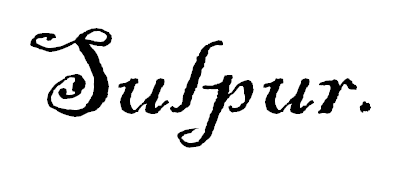How do you spell sulfur?
- H. Procter

- Apr 1, 2019
- 4 min read
Many of the words in English come from Greek, Latin, or Anglo-Saxon origins. Etymologists make it their livelihood to study and understand the origins of words to firstly understand how families of words are connected, but also to inform better rule creation for spelling and grammar use. Yes, they are part of the grammar police who keep telling users not to use “leet speak” or keep us on the straight and narrow when it comes to signage and formal documents. Etymology is not precise, so the origins of words are always academic assumptions based on literature backed study, they are dynamic due to the reading of older documents that correct the current understanding.
Sulfur: what is its origin?
The word sulfur entered Modern English use from the Latin word Sulpur or Sulpureus. Scholars at the time (who were also fluent in Greek) would vary the spelling between sulphur, sulpur and sulfur seemingly because the Greek letter for phi (φ) was the only analogue for “f”, pronounced “ph”, as in phone. Latin scholars seemed to be uncomfortable in using their “f” invention. By the third century BC Latin speakers had settled on sulfur as the official spelling. The Greeks used the word theion, (which gives rise to thio- prefix that is often used in naming sulfur functional groups) so etymologists know the root lay in Latin not Greek origins.
British and American differences in spelling
With the birth of Modern English in the 14th century, the English speakers had shunned the French word Soufre, and had adopted sulphur as mainstream spelling. Interestingly, the English language took a fork in the road when the American colony decided to officially use Modern English after gaining their independence (in 1776). The Americans had settled on the spelling of sulfur by the turn of the 20th century. The American etymologists had recognised its Latin roots and had dispelled with the Greek phi misinterpretation. The Americans get very insistent about the spelling making a certain point of spelling sulfur containing compounds in the 1920s and 1930s.
British English speakers persisted with the sulphur. Interestingly both English and American English speakers had gone with not capitalising (unless if starting a sentence) common chemicals in a manner that is sometimes seen in Latin. With the role that the British Empire played in institutionalising English into its colonies education systems it was just a matter of time that the spelling of sulfur that dominated English speak world was going to be sulphur. British etymologists seemed to have other affairs dominating their minds with the anglicisation of local words. South African universities and schools adopted the sulphur spelling and used British textbooks to make chemistry students conform to the global spelling. Increasing use of the sulfur spelling started to make larger journal publishers question their spelling policies and it was inevitable major discussion would take place at international level.
International Union of Physical and Applied Chemistry
Then comes the period of 1971 to 1990, where the International Union of Physical and Applied Chemistry repeatedly publishes its definitive table of inorganic chemical nomenclature: “Nomenclature of Inorganic Chemistry’. This publication contains a table of IUPAC-approved names ‘for use in the English language’ with clear guidance for the correct spelling of sulfur, aluminium and caesium to reflect the agreed international consensus. Chemists have now been handed a certain directive by IUPAC, their governing body.
It was only a matter of time before the Royal Society of Chemistry adopts the consensus and they publish, as a communication, in their Journal of Materials Chemistry the information for their members in 1991. Their Editorial guidelines officially changed and authors now need to submit all manuscripts with the IUPAC spelling or face rejection. Nature Chemistry, followed by all Nature journals follows suite and it is a now a question of time that all UK journals follow suit. By the late 2000s most UK universities teach the IUPAC spelling and now the sulphur spellers hold doggedly on as dissenters, rather than the norm.
Current Situation
Some publishers and educational institutes still contain no formal guidance or notes to contributors with the adoption of either spelling being allowed, if the writing is consistent in its use. In general chemists, have made the change to the correct form and it is only the users of sulphur who haven’t heard about the IUPAC ruling or can’t be bothered to change. Many people say: “Language is our slave, not our master” and that it should adapt with the times.
The communication by digital platforms have resulted in the widespread use of “leet speak”, where users drop vowels, substitute letters for phonetic sounds, and shorten words to be able to send maximum information in one short message. “CU l8r”, is taken to mean “see you later”, so that messages can be typed and sent faster. Some take this as the main reason why lazy people want to use the word sulfur rather than the longer form sulphur. But, the case cannot be clearer – it is incorrect to use the sulphur etymologically.
In the leather publications, the Journal of the American Leather Chemists Association has always had contributor notes advising of the sulfur spelling and will change your manuscript on submission because of the American spelling, galvanised by the IUPAC ruling. The Journal of the Society of Leather Technologists and Chemists have accepted both variants and a scan of the issues shows equal amounts of the sulfur/sulphur variants. More recent issues tend to favour the correct spelling of sulfur, which is probably an indication of the UK adoption, but many articles from the Indian sub-continent show a reluctance to change (or a perpetuation of colonial education).
The leather textbooks recently published show that tanners have started to embrace the change too.







Comments